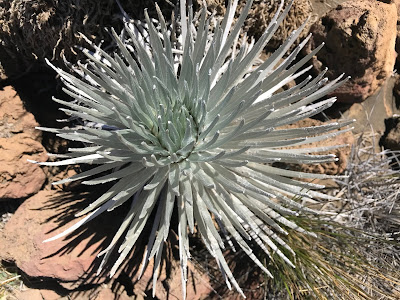At 13,796-feet, Mauna Kea is the highest point on the Big Island, and on all of Hawaii. It is 125 feet higher than its more massive neighbor, Mauna Loa. The two volcanoes offer a stunning landscape perched high on either side of Saddle Road, which runs between Kona and Hilo, and is the quickest way to travel across island.
The road from Kona to Mauna Kea is in good shape and takes about 1.5 hours. A few miles west of the entrance on Saddle Road is the Mauna Kea Recreation Area, which is a great place to stop and stretch: excellent, clean bathrooms, picnic tables, outdoor exercise equipment designed by physicists.
Across from the entrance to Mauna Kea is Pu'u Hulululu ("Hairy Hill"). This is another nice spot to stop and take a short hike (0.7 miles round trip). The air is dry in these parts, so take lots of water. This was a lovely hike to take in the vast landscape.
The Mauna Kea visitor's center, known as the Onizuka Center for International Astronomy Visitor Information Station, is 6 miles up the Mauna Kea Access Road at 9,200 feet. It is an easy drive on a paved road. The visitor's center, run by the University of Hawaii, is tiny and they were working on the entrance and parking, so it seemed even smaller. There are bathrooms and picnic tables and some information about the summit and weather conditions, although the staff were not particularly helpful or friendly. Apparently they aren't allowed to recommend any trail hiking due to liability concerns.
We opted not to drive the final 9 miles to the top, which is mostly gravel and steep and the air gets really thin. It would have been nice to see the 13 telescopes and take in the view, but we didn't want to test our 8-passenger rented Suburban nor the thin air. Here's the sign that causes many not to drive to the top:
I did learn about a cool plant at the visitor's center: the rare and endangered silversword that is endemic to Haleakala on Maui and Mauna Kea and Mauna Loa on the Big Island. There is a fenced off area behind the visitor's center where the plant grows and was in flower -- apparently a rare occurrence as these plants bloom once in 15-50 years, then die. Each of the three locations where the silversword is found supports a different subspecies (Maui and Mauna Kea) or species (Mauna Loa).
Silverswords were decimated by grazing pigs, goats, sheep, and cattle. The Mauna Kea silversword, Argyroxiphium sandwicense sandwicense, is federally endangered, with less than 50 thought to exist. So we saw a large part of the population. The plant is characterized by a dense rosette of silvery, spiky (but soft) leaves that radiate out from the base. It sends up a tall bloom (up to 6 feet) that sports hundred of purple, aster-like flowers.
From the visitor's center we hiked to nearby Sunset Hill, which offered nice views of the visitor's center, Mauna Kea summit (although the telescopes are on the north side and not visible), stunning landscape over to Mauna Loa, and looking down into a cinder cone. As you can see from the photos, we had stunning weather.


























No comments:
Post a Comment